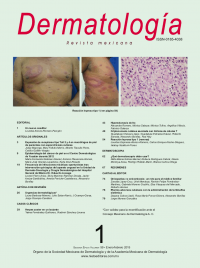Resumen
Antecedentes: la esporotricosis es una infección que afecta la piel y el tejido subcutáneo y linfático, causada por el complejo Sporothrix schenckii. En esta micosis interviene la respuesta inmunitaria innata (monocitos-macrófagos y polimorfonucleares), debido a que Sporothrix tiene en su pared celular glicoproteínas que pueden ser reconocidas por los receptores tipo Toll 2 y 4, es importante estudiar la participación de estos receptores. Existen escasos estudios, efectuados únicamente en modelos murinos, que evalúan estas moléculas durante la respuesta inmunitaria en la esporotricosis. Objetivo: determinar la expresión de receptores tipo Toll (TLR) 2 y 4 en macrófagos de biopsias de piel de pacientes con esporotricosis cutánea. Material y método: estudio transversal analítico, que incluyó tejido de biopsia de pacientes con esporotricosis y controles. Se usó técnica de inmunohistoquímica, con anticuerpos monoclonales anti TLR2, TLR4 y CD68 (control positivo a macrófagos), revelados mediante el paquete Universal Dako. Las cortes inmunoteñidos se observaron por medio de microscopio óptico para identificar el índice de marcaje por su intensidad y extensión de color en el tejido. Resultados: el índice de marcaje de los receptores TLR2 y TLR4 se observó en la membrana de los queratinocitos, con menor expresión en los pacientes vs los controles con diferencia estadísticamente significativa en TLR4 (p=0.002). Conclusión: las moléculas de receptores tipo Toll 2 y 4 se expresaron en la membrana de los queratinocitos y no en macrófagos. Palabras clave: esporotricosis, macrófagos, receptores tipo Toll 2 y 4.
Palabras clave: esporotricosis, macrófagos, receptores tipo Toll 2 y 4
Abstract
Background: Sporotrichosis is an infection of skin, subcutaneous and lymphatic tissue, caused by Sporothrix schenckii complex. In this mycosis, it is involved the innate immune response (monocytes/macrophages and polymorphonuclear), so it is important to study the involvement of Toll-like receptors (TLR), as Sporothrix presents in its cell wall glycoproteins that can be recognized by TLR2 and TLR4. There are few studies (and only in murine models) evaluating these molecules during the immune response in sporotrichosis. Objective: To determine the expression of TLR2 and TLR4 in macrophages in skin biopsies from patients with cutaneous sporotrichosis. Material and method: A cross-sectional, analytical study was done with tissue biopsies from patients with sporotrichosis and controls with immunohistochemistry, using monoclonal antibodies against TLR2, TLR4 and CD68 (positive control macrophages), revealed by Universal Dako kit. The immunostained sections were observed by light microscopy to identify the labeling index by a visual analog scale (color intensity and extension in the tissue). Results: The labeling index of receptors TLR4 and TLR2 was observed with lower expression in patients versus controls, with a statistically significant difference in TLR4 (p=0.002). Conclusion: There was no expression of TLR2 and TLR4 in macrophages of patients with sporotrichosis, these molecules were present in the membrane of keratinocytes. Key words: sporotrichosis, macrophages, Toll-like receptors 2 and 4.
Keywords: sporotrichosis, macrophages, Toll-like receptors 2 and 4

